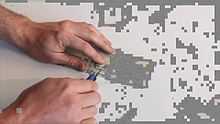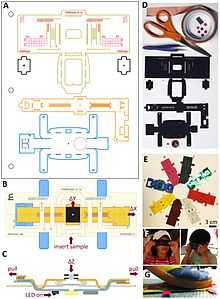Foldscope


A Foldscope is an optical microscope that can be assembled from simple components, including a sheet of paper and a lens. It was developed by Manu Prakash and designed to cost less than US$1 to build.
Overview
A Foldscope is an optical microscope that can be assembled from a punched sheet of cardstock, a spherical lens, a light emitting diode and a diffuser panel, along with a watch battery that powers the LED.[2] It can magnify up to 2000 times and weighs 8 grams. The magnification power is enough to enable the spotting of organisms such as Leishmania donovani and Escherichia coli, as well as malarial parasites.[3] A Foldscope can be printed on a standard A4 sheet of paper and assembled in seven minutes.[4]
The basic principle of using a small spherical lens held close to the eye dates back to Antonie van Leeuwenhoek (1632-1723), who was the first to see single-celled organisms using such a lens held in a device of his own design.
The Foldscope was developed by a team led by Manu Prakash, an assistant professor of bioengineering at the Stanford School of Medicine.[5] The project was funded by several organisations including the Bill & Melinda Gates Foundation, which gave a grant of US $100,000 for research in November 2012. The Gordon and Betty Moore Foundation funded the "Ten Thousand Microscopes" project under which Prakash plans to give away 10,000 Foldscope kits to interested parties, including students for research.[3][6][7] Foldscope sets will also be produced and tested in Kenya, India and Uganda.[4]
Twelve Foldscope variants are available, each designed to aid the identification of a particular disease-causing organism.[4] To enable several people to use them at once, each microscope can project images with a built-in projector.[4] The Foldscope is designed to be assembled by the end user, and hence is colour-coded to help with the assembly.[3] Each unit costs less than one US dollar to build, with estimates varying from 50 cents to 97 cents.[3][4]
References
- ↑ 1.0 1.1 Cybulski JS, Clements J, Prakash M (2014). "Foldscope: origami-based paper microscope.". PLoS One 9 (6): e98781. doi:10.1371/journal.pone.0098781. PMC 4062392. PMID 24940755.

- ↑ Mathews, Lee (11 March 2014). "Foldscope is a 50-cent paper microscope that magnifies up to 2000 times". Geek.com. Retrieved 13 March 2014.
- ↑ 3.0 3.1 3.2 3.3 Mukunth, Vasudev (12 March 2014). "A disposable microscope for as little as $1". The Hindu. Retrieved 13 March 2014.
- ↑ 4.0 4.1 4.2 4.3 4.4 Wakefield, Jane (11 March 2014). "Ultra-cheap 'origami' microscope developed". BBC News. Retrieved 13 March 2014.
- ↑ Coxworth, Ben (11 March 2014). "Folding paper microscope could reduce deaths from malaria". Gizmag. Retrieved 13 March 2014.
- ↑ Newby, Kris (13 March 2014). "Free DIY microscope kits to citizen scientists with inspiring project ideas". Scope. Retrieved 13 March 2014.
- ↑ "Foldscope paper microscope can diagnose malaria, costs 50 cent". CBC News. 13 March 2014. Retrieved 13 March 2014.
Further reading
- Stanford bioengineer develops a 50-cent paper microscope on Stanford Medicine [Scope Blog]
- Stanford microscope inventor featured on TED Talk on Stanford Medicine [Scope Blog]
- Foldscope: Origami-based paper microscope, James Cybulski, James Clements, Manu Prakash, 5 March 2014, Cornell University Library.
External links
| Wikimedia Commons has media related to Foldscope. |